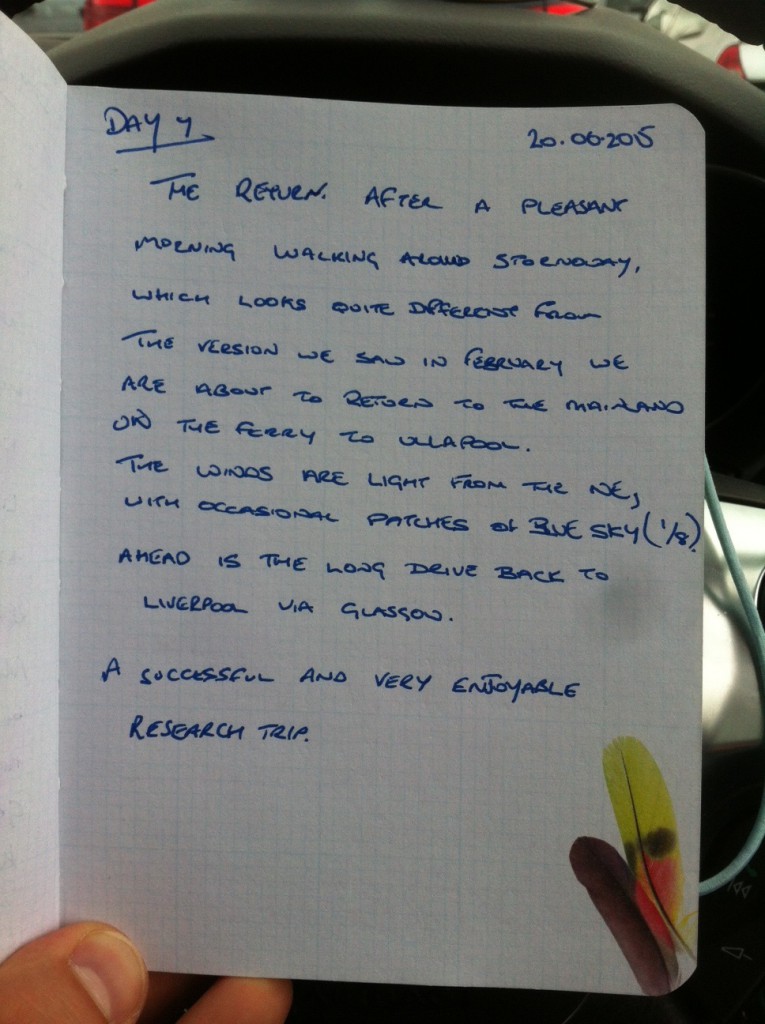
June 15, 2015, by James
‘The Journal of a Tour to the Hebrides!’
Following in the footsteps of Martin Martin (-1718), Thomas Pennant (1726-98), James Boswell (1740-95) and Samuel Johnson (1709-84), Neil Macdonald (who could almost be mistaken for being a native islander given his surname), Simon Naylor (a Cornish Glaswegian) and James Bowen (a regular tourist to the islands), travelled to the remote Outer Hebrides, to undertake cutting edge historical research into past extreme weather events. This is their story…
Day 1 Three men in a boat!
Having driven from Liverpool to Glasgow, the three travellers continued along the Great Western Road (A82) past Dumbarton and Loch Lomond to the port of Oban, from where we sailed on the Caledonian MacBrayne ferry from Oban to Castlebay, Isle of Barra. Lodged at the Dunard hostel overlooking Kisimul Castle, the harbour and the island of Vatersay.
The weather today was…
Day 2 Whisky Galore!
Visited Castlebay Community Library to view school log books for the islands of Barra and Vatersay. In the evening a tour the islands of Barra and Vatersay which are connected by a causeway. View south from Vatersay towards the islands of Sandray, Pabbay, Mingulay (evacuated 1912) and Barra Head lighthouse built by Robert Stevenson in 1833. Barra is famous for Compton Mckenzie’s comic novel ‘Whisky Galore’ (1947) which is set in the Hebrides and is based on the running aground of the S.S. Politician in 1941 during a storm.
The weather today was…
Day 3 Touring the Uists.
Early ferry from Barra to Eriskay across the Sound of Barra to South Uist. Heading north past Lochboisdale we admired the views of the machair which carpets the low-lying western coastline, observing coastal dunes, lagoons and the overtopping of barrier islands as well as marram grass and sand blown fences. Arrived at Lionacliet Community Library, Isle of Benbecula where we stayed for two nights.
The weather today was…
Day 4 Time for Tweed – the Isle of Harris.
Drove across the causeway linking Benbecula with South Uist where a family was tragically killed during a storm 11 January 2005. Causeways have been constructed to create an integrated transport network, but are proving vulnerable to the effects of climate change.
Another ferry crossing, this time between Berneray and Leverburgh across the Sound of Harris (Caolas na Hearadh) which is 8 miles wide and is the main sea passage through the Hebridean archipelago from the Atlantic Ocean to The Minch. Arrived at Leverburgh and continued on to Tarbet, Isle of Harris where we spent the day at Tarbet Community Library viewing more school log books. After another long day we drove up to the town of Stornoway, Isle of Lewis – the capital of the Hebrides.
The weather today was…
Day 5 Back in Stornoway!
Spent the day in Stornoway library viewing more school log books. Met with Eddy Graham at Lews Castle who showed us the sites of weather stations in and around Stornoway. In the evening we drove out and visited the Iolaire Disaster monument at Holm and the Butt of Lewis lighthouse built by David and Thomas Stevenson in 1862.
The weather today was…
Day 6 Ferry across the Minch (An Cuan Sgìth, Cuan na Hearadh, An Cuan Leòdhasach).
We sailed on the new Caledonian MacBrayne ferry ‘Loch Seaforth’ from Stornoway to Ullapool and began the long drive back to Liverpool via Glasgow!
The weather today was…
Day 7
The End.
Previous Post
Edward Joseph Lowe and extreme weather observationsNext Post
Heatwave!No comments yet, fill out a comment to be the first








Leave a Reply